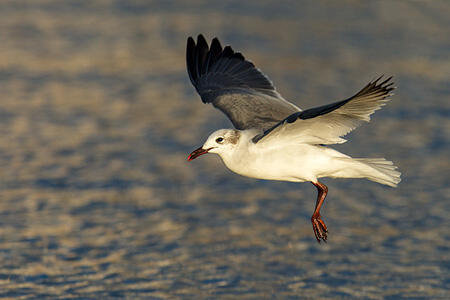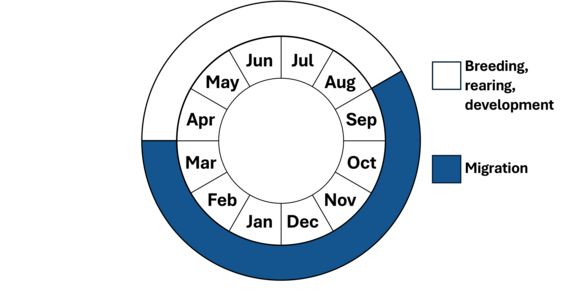- Scientific name: Leucophaeus atricilla
- Species of Greatest Conservation Need (MA State Wildlife Action Plan)
Description

Small coastal gulls, laughing gulls are 39-46 cm (15-18 in) in length, weigh 203-271 g (7.2-13.1 oz), and have a 92-120 cm (36-47 in) wingspan. Adults in breeding plumage have a black head, white marks around the eyes, dark gray back and wings, black wing tips, and white tail. Breeding adults also have a reddish bill. Immature laughing gulls are browner with a dark bill and won’t have full adult plumage for 2-3 years. Their bills are fairly long and stout, and their call is a strident laugh: ha-ha-ha-ha-ha-haah-haah-haah.
Life cycle and behavior

Laughing gulls can be seen soaring in the sky, standing in groups, or paddling in water. They will chase after other coastal birds to try and take their food. Laughing gulls with display toward and threaten one another by extending their neck and head, repeatedly calling, ruffling their feathers, and flapping their wings.
Laughing gulls are monogamous and will remain in the same pairs for multiple breeding seasons. Pairs will both build the nest, usually on sand, rocks, or dead vegetation. The female will lay 2-4 eggs and both birds incubate the eggs for 22-27 days. While chicks are capable of leaving the nest 24 hours after hatching, they tend to stay in the nest for days camouflaged by down. Chicks can be predated by weasels, other gulls, and birds of prey.
Population status
The North American Breeding Bird Survey conducted from 1966-2022 showed that laughing gulls increased by 0.6% annually between 1966-2022. The North American Conservation Plan estimates that there are over 520,000 breeding birds. However, numbers of breeding laughing gulls in Massachusetts have declined substantially over the past 60 years, with 1,200 pairs nesting in 2003, down from over 20,000 pairs as recently as the early 1940s. The population has been rebounding in recent years and in 2024, 7,365 nesting pairs were documented in Massachusetts, but essentially all of them were located at a single site.
Distribution and abundance

Laughing gulls occur along much of the Massachusetts coastline from April through November, but currently nest in a single colony on South Monomoy Island, Chatham. A former colony on New Island in Eastham was recently abandoned after natural processes of shoreline migration connected it to Nauset Spit, allowing access by mammalian predators.
Habitat
This gull nests colonially on sandy islands and the remote ends of sand spits. It forages along the shore and in coastal bays and inlets and channels of salt marshes, feeding on crustaceans, other invertebrates and small fish.
Healthy habitats are vital for supporting native wildlife and plants. Explore habitats and learn about conservation and restoration in Massachusetts.
Threats
Primary threats to laughing gulls are loss of secure nesting habitat because of competition from greater black-backed gulls and American herring gulls, mammalian predation, and oil spills. Their nests are threatened by human disturbance, including development of beach front property, off-road vehicles, and off-leash dogs. The continued presence of laughing gulls as a breeding species in Massachusetts is threatened by the limited number of nesting colonies in the state. Like other island nesting species, the laughing gull is vulnerable to sea level rise.
Conservation
Conservation actions for this species in Massachusetts should focus on the protection of nesting colonies.
References
Burger, J. 1996. Laughing Gull (Larus atricilla). In The Birds of North America, No. 225 (A. Poole and F. Gill, eds.). The Academy of Natural Sciences, Philadelphia, PA, and The American Ornithologists’ Union, Washington, D.C.
Petersen, W.R., and W.R. Meservey. 2003. Massachusetts Breeding Bird Atlas. Massachusetts Audubon Society and University of Massachusetts Press, Amherst, Massachusetts.
Veit, R., and W.R. Petersen. 1993. Birds of Massachusetts. Massachusetts Audubon Society, Lincoln, Massachusetts.
Contact
| Date published: | May 16, 2025 |
|---|